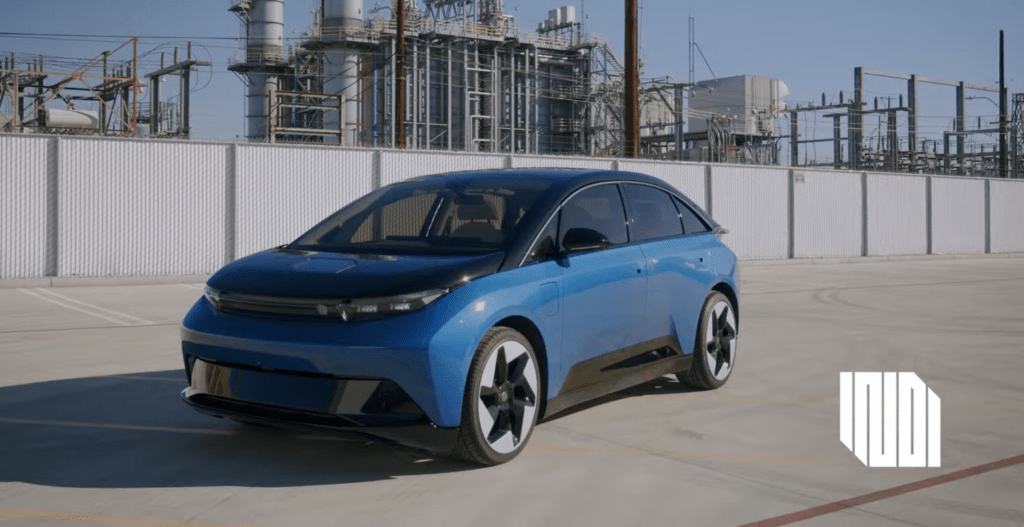Whenever there is a significant technology change, the first iterations often try to emulate what came before. The first cars looked a lot like horse-drawn carriages without the horses and were called Horseless Carriages. Over a considerable number of decades, they’ve evolved to a point where they are now optimized for what they are, not what their horse-drawn predecessors were.
With the current wave of electric vehicles (EVs), Tesla’s pretty much looked the same as internal combustion engine (ICE) cars even though they didn’t need space in front for motors. Later cars, like the Jaguar I-PACE, had a more cab-forward design that was made possible by the very different needs of an electric car.
The Indi EV is taking what may be seen as the next logical step by taking what was learned from Tesla and making a vehicle far more focused on what we do today than what we did last century. We’ve learned that Tesla drivers like to engage on YouTube using Tesla cameras to record what the drivers have seen. Tesla cars do this better than any other car at the moment, but they weren’t designed with this in mind, leaving the door open for a new carmaker, Indi, to create a more focused social media-oriented car, the Indi One.
Base specs
The car has an even more aggressive cab-forward design than the I-PACE, has decent but not world-shattering specs, like a three-hundred-mile range, support for 100-kilowatt charging, level 2+ autonomous driving, a 0 to 60 time of a moderate 5.5 seconds, dual engines, and a price that starts at a reasonable $45K. Fully loaded the car is closer to a still-reasonable $60K.
However, these specs are how we looked at ICE cars, much like when we lost the horses. Now that we are moving to electric cars, we have far more ways to engage and entertain ourselves, and other cars need to evolve. The Indi One points to one possible path.
The car for this century
At the front of the car, where other electrics often have a Frunk, the Indi EV has a complete Windows workstation that can be upgraded and replaced as technology advances. This workstation provides several unique in-car features, like the ability to select and use multiple surround and internal cameras during conference calls and record events that can be shared on a variety of social media platforms.
Say you need to join a Zoom, Teams, or WebEx meeting. You can use that integrated PC and then use one of the in-cabin cameras to capture you or your passenger(s) on the call. Suddenly your car is a Zoom Room, and you can select different cameras if, during the meeting, you want to show what you are seeing or share what a pet or child is doing to create that annoying background noise.
Like many current cars, the car has an always-on connection, but, in this case, it is 5G which provides the needed bandwidth and extended connectivity to make these connected use cases possible. In addition, the car has twin large 15-inch in-car displays. One that displays car functions for the driver while the other can be the passenger’s video conferencing screen or entertainment screen (gaming/videos). I expect this feature will be more helpful once the Indi EV gets level 3+ autonomous driving capability in a few years, and the driver can then enjoy some of these capabilities as well.
To keep the passengers occupied in the front and back seats, the car will support AAA gaming and VR (motion sickness may be a problem), turning the car into a mobile game center. Current PC performance is based on an Intel Core I7 and NVIDIA GTX 2030 GPU, but this will likely be upgraded by launch. And the modular configuration of the related computer uniquely allows for regular upgrades, which will be critical to the success of this feature because an out-of-date PC would otherwise prematurely obsolesce these capabilities.
Wrapping up
The Indi One represents one of many EV pivots that the car industry is likely to take in the future to address the different capabilities of an electric vehicle and the opportunities to create something more in line with today’s needs and interests, in this case, social networking. The car is due to arrive in the 2023 timeframe, has an affordable target price, and is somewhat conflicted, having entertainment capabilities but lacking the autonomous driving features that would make many of these capabilities attractive to a solo driver.
The Indi One is an exciting effort primarily because it better addresses the likely future priorities of an ever more connected world. We likely should call this the birth of the Social Network car. It will be fascinating to see if this concept survives and what it will eventually evolve to become.
- Is Windows the New Internet Explorer? How Microsoft Is Slowly Killing Its Most Iconic Product - October 17, 2025
- Checkmate? Lenovo’s ‘AI in a Box’ Is a Brilliant Ambush on Dell - October 15, 2025
- The Ambient Brain: Why Amazon’s Alexa+ Is the AI We’ve Been Waiting For - October 4, 2025



